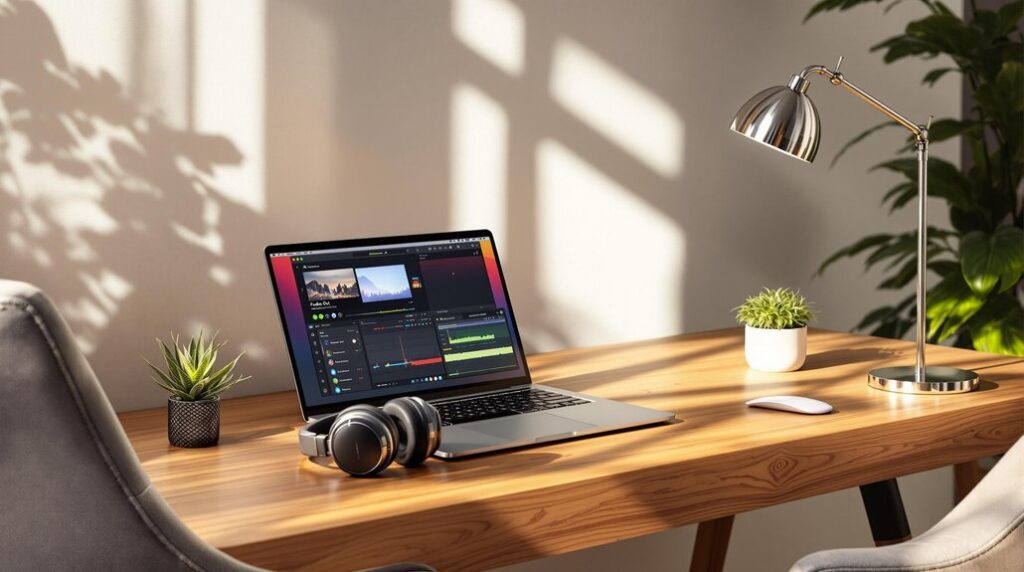Adding a fade-in effect in GarageBand is efficiently accomplished in three steps. Start by accessing the Master Track via Track > Show Master Track in the menu. This vital tool allows control over the entire mix's volume automation. Subsequently, press "A" to reveal the automation menu and choose "Volume." Click along the yellow line to create volume points that represent your fade-in progression. Establish a silent starting point and gradually raise volume to desired levels using these points. Preview your adjustments to guarantee seamless integration. By following these steps, a polished audio shift becomes attainable with further intricacies awaiting exploration.
Key Takeaways
- Open the track and access the automation menu using the "A" shortcut.
- Click the yellow volume line to create volume points for fading.
- For fade-in, set an initial point at silence and a second for progression.
- For fade-out, create points towards the end, reaching silence gradually.
- Preview the track to ensure smooth transitions and adjust as needed.
Access the Master Track
To effectively manage the overall audio levels and apply effects such as fade-ins and fade-outs, accessing the Master Track in GarageBand is essential.
Navigate to the menu bar and select Track > Show Master Track to reveal this pivotal feature. The Master Track serves as the centralized hub for controlling volume and effects across your entire music production, ensuring a cohesive sound.
By utilizing the Master Track, you can create automatic fades by adding points along the volume line, allowing for precise control over your project's dynamics. This capability to add and adjust fades enhances the professionalism of your final mix.
Visually identifiable in the track header, the Master Track is indispensable for seamless audio level management during music production. Utilizing automation on the Master Track allows precise control over parameters like volume, enhancing the dynamic shaping of your mix.
Set Volume Automation
Mastering volume automation in GarageBand is essential for achieving a polished and dynamic audio mix. To begin, select the desired track and access the automation menu using the shortcut "A." This reveals the volume envelope for the track. From the dropdown, choose "Volume" and proceed to create a fade by clicking on the yellow line to establish volume points. These points allow precise control, facilitating an automatic fade and guaranteeing seamless shifts, such as a smooth Fade Out in GarageBand. Drag the volume points to adjust the volume at specific moments, thereby enhancing the musical dynamics. Make certain to listen to your adjustments during playback. This guarantees the automation integrates seamlessly with your track's overall sound profile. Regularly playback sections to ensure smooth and seamless transitions, mirroring fade-out automation for cohesive fade-in effects.
Adjust Fade-In Points
When creating a fade-in effect in GarageBand, understanding the precise placement of volume points is essential for achieving a seamless audio introduction.
To adjust fade-in points, begin by selecting the desired track and accessing the automation menu using the "A" shortcut.
Locate the yellow line representing volume, and create volume points to define the fade-in effect. Establish the initial volume point at the track's start by dragging it to the bottom, ensuring a silent beginning.
Introduce a second volume point along the line, adjusting its position to achieve a smooth progression to the desired volume level.
Finally, preview the track to confirm that the fade-in effect integrates harmoniously with the overall composition dynamics, maintaining audio integrity.
Frequently Asked Questions
How to Add Fade in Garageband?
To add fade in GarageBand, utilize volume automation within audio editing. This involves manipulating sound effects, track layering, and waveform visualization. Integrate plugin usage, stereo imaging, and project organization for seamless audio mixing and professional music production.
How Do You Fade Songs Together in Garage Band?
To fade songs together in GarageBand, employ volume automation and track layering for seamless audio shifts. This mixing technique enhances song arrangement, enabling creative editing and genre blending while maintaining sound design integrity amidst tempo changes in music production.
How to Add Fade Out Audio?
To effectively add fade-out audio, employ volume automation techniques and audio editing tips. Mastering audio fades involves creating smooth shifts through mixing techniques, sound design, and track layering, ensuring creative fading and seamless integration of audio effects.
How to Fade Pitch in Garageband?
To fade pitch in GarageBand, employ pitch shifting and track automation for precise audio effects. Enhance sound design by integrating vocal tuning, creative mixing, and melody enhancement, facilitating tempo changes and genre blending for advanced music production techniques.
Conclusion
In summary, the process of adding a fade-in effect in GarageBand is streamlined and efficient when following these three steps. Accessing the Master Track allows users to manage overall sound dynamics, while setting volume automation provides precise control over audio levels. Finally, adjusting fade-in points guarantees a smooth and gradual increase in volume, enhancing the auditory experience. This methodical approach assures that users can achieve professional-sounding audio shifts with minimal effort and maximum precision.




